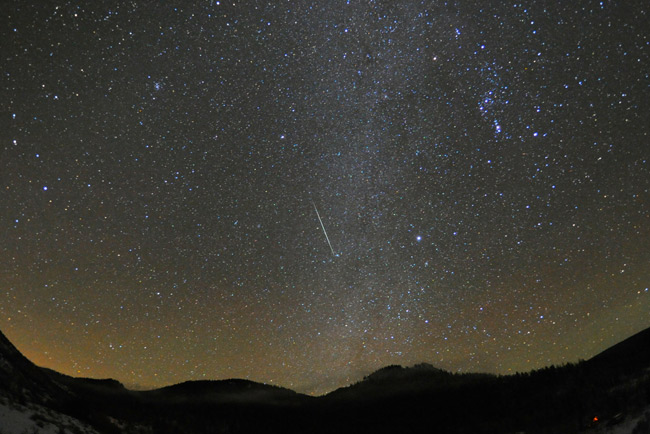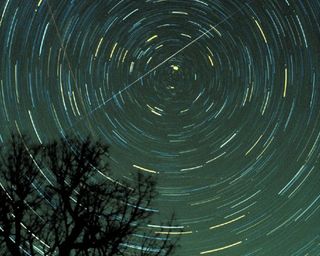December's Geminid Meteor Shower Peaks Tonight

The Geminid meteor shower peaks tonight (Dec. 13), but interested skywatchers might have to battle chilly temperatures and bright moonlight.
The annual Geminids shower is usually one of the most spectacular light shows of the year, but this time around, the vivid and nearly full moon is threatening to take center stage instead.
On Dec. 10, lunar observers were treated to a stunning total lunar eclipse, and the moon's dazzling light in the night sky is expected to make it difficult to spot Geminids as the shower reaches its peak tonight.
"This year, folks will get a nice double whammy with the lunar eclipse on the 10th, and then the Geminid peak on the night of the 13th, but it would be nice if we could just turn off the moon after the eclipse," Bill Cooke, head of the Meteoroid Environments Office at NASA's Marshall Space Flight Center in Huntsvilla, Ala., told SPACE.com.
December's light show
The annual Geminid meteor shower has become known as one of the most impressive of the year, sometimes even eclipsing the more famous Perseid meteor shower that occurs every August.
"It's a relatively young meteor shower," Cooke said. "It didn't really turn on until the 1830s, and it may have been first seen from a Mississippi river boat back then. But they've been gradually increasing in strength over the years, and now they're the strongest meteor shower of the year." [Most Amazing Leonid Meteor Shower Photos]
Get the Space.com Newsletter
Breaking space news, the latest updates on rocket launches, skywatching events and more!
The Geminids shower also features slow and bright meteors, with some of them appearing yellowish in color, said astronomer Joe Rao, SPACE.com's skywatching columnist. On a clear night, skywatchers have reported seeing up to 120 meteors per hour during the peak of the Geminids in previous years.
This year, however, skywatchers will likely see about half that rate, Cooke said.
"There will probably be around 40 or 50 per hour on the night of the 13th," he said. "Unlike the Perseids, it will be really cold, so folks need to remember to dress warm. The Geminids are noted for bright meteors, and there can be a lot of them. The shower is probably the best meteor shower to watch when the moon isn't getting in the way. So, if you can brave the cold, the Geminids will not disappoint, in general."

Lighting up the night sky
Occasionally, the Geminids can produce stunning fireballs, and if that happens this year, they should be bright enough to see even with the moonlight.
Meteors are often referred to as "shooting stars," but these streaks of light actually come from pieces of debris that hit Earth's atmosphere and burn up. Larger pieces that dive through the atmosphere can cause unusually bright meteors, which are called fireballs.
Most meteor showers are the remnants of comets, but the Geminids are a little different. The source of these meteors is a strange asteroid called 3200 Phaethon, which sheds bits of dusty debris.
This space rock orbits closer to the sun than any other known asteroid, coming well inside Mercury's orbit. This behavior makes 3200 Phaethon more like a comet than an asteroid, astronomers have said, but it the object has never exhibited any other features that would classify it as a comet, such as a coma, gas jets or a tail.
The Geminid meteor shower gets its name from the constellation Gemini, since the meteors appear to radiate from this point in the sky. When we look toward this spot, we are actually looking into the line of 3200 Phaethon's orbit, scientists have said.
While this year's Geminid meteor shower may be more subdued, next year's light shows are already showing more promise. The Quadrantids will be the next major meteor shower; skywatchers can expect these to peak on the night of Jan. 3, 2012.
The rest of the 2012 meteor shower lineup looks to be more impressive, with moonlight becoming less of a factor as the year progresses, Cooke said.
"Next year will be a better year for meteor showers, as far as moonlight is concerned," he said.
Editor's Note: If you do happen to catch a photo of the Geminids this year, and would like to share it for a possible story or gallery on SPACE.com, please email managing editor Tariq Malik at tmalik@space.com.
You can follow SPACE.com staff writer Denise Chow on Twitter @denisechow. Follow SPACE.com for the latest in space science and exploration news on Twitter @Spacedotcom and on Facebook.
Join our Space Forums to keep talking space on the latest missions, night sky and more! And if you have a news tip, correction or comment, let us know at: community@space.com.

Denise Chow is a former Space.com staff writer who then worked as assistant managing editor at Live Science before moving to NBC News as a science reporter, where she focuses on general science and climate change. She spent two years with Space.com, writing about rocket launches and covering NASA's final three space shuttle missions, before joining the Live Science team in 2013. A Canadian transplant, Denise has a bachelor's degree from the University of Toronto, and a master's degree in journalism from New York University. At NBC News, Denise covers general science and climate change.